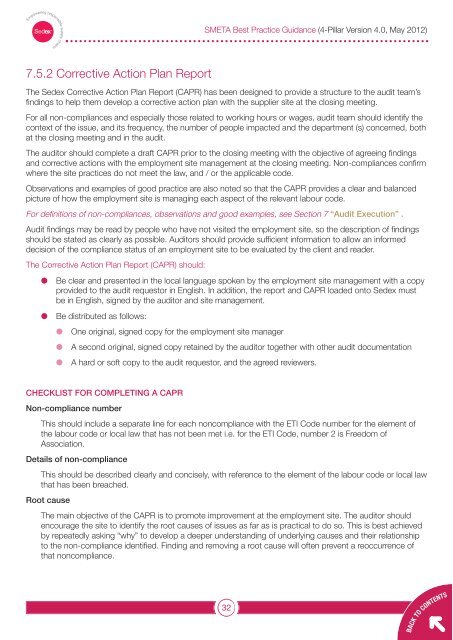Sedex Members Ethical Trade Audit (SMETA) Best Practice Guidance
Sedex Members Ethical Trade Audit (SMETA) Best Practice Guidance
Sedex Members Ethical Trade Audit (SMETA) Best Practice Guidance
Create successful ePaper yourself
Turn your PDF publications into a flip-book with our unique Google optimized e-Paper software.
7.5.2 Corrective Action Plan Report<br />
The <strong>Sedex</strong> Corrective Action Plan Report (CAPR) has been designed to provide a structure to the audit team’s<br />
findings to help them develop a corrective action plan with the supplier site at the closing meeting.<br />
For all non-compliances and especially those related to working hours or wages, audit team should identify the<br />
context of the issue, and its frequency, the number of people impacted and the department (s) concerned, both<br />
at the closing meeting and in the audit.<br />
The auditor should complete a draft CAPR prior to the closing meeting with the objective of agreeing findings<br />
and corrective actions with the employment site management at the closing meeting. Non-compliances confirm<br />
where the site practices do not meet the law, and / or the applicable code.<br />
Observations and examples of good practice are also noted so that the CAPR provides a clear and balanced<br />
picture of how the employment site is managing each aspect of the relevant labour code.<br />
For definitions of non-compliances, observations and good examples, see Section 7 “<strong>Audit</strong> Execution” .<br />
<strong>Audit</strong> findings may be read by people who have not visited the employment site, so the description of findings<br />
should be stated as clearly as possible. <strong>Audit</strong>ors should provide sufficient information to allow an informed<br />
decision of the compliance status of an employment site to be evaluated by the client and reader.<br />
The Corrective Action Plan Report (CAPR) should:<br />
l Be clear and presented in the local language spoken by the employment site management with a copy<br />
provided to the audit requestor in English. In addition, the report and CAPR loaded onto <strong>Sedex</strong> must<br />
be in English, signed by the auditor and site management.<br />
l Be distributed as follows:<br />
l One original, signed copy for the employment site manager<br />
l A second original, signed copy retained by the auditor together with other audit documentation<br />
l A hard or soft copy to the audit requestor, and the agreed reviewers.<br />
CHECKLIST FOR COMPLETING A CAPR<br />
Non-compliance number<br />
This should include a separate line for each noncompliance with the ETI Code number for the element of<br />
the labour code or local law that has not been met i.e. for the ETI Code, number 2 is Freedom of<br />
Association.<br />
Details of non-compliance<br />
This should be described clearly and concisely, with reference to the element of the labour code or local law<br />
that has been breached.<br />
Root cause<br />
<strong>SMETA</strong> <strong>Best</strong> <strong>Practice</strong> <strong>Guidance</strong> (4-Pillar Version 4.0, May 2012)<br />
The main objective of the CAPR is to promote improvement at the employment site. The auditor should<br />
encourage the site to identify the root causes of issues as far as is practical to do so. This is best achieved<br />
by repeatedly asking “why” to develop a deeper understanding of underlying causes and their relationship<br />
to the non-compliance identified. Finding and removing a root cause will often prevent a reoccurrence of<br />
that noncompliance.<br />
32<br />
BACK TO CONTENTS


